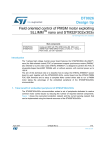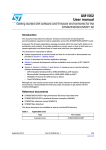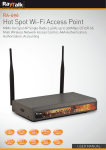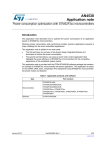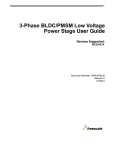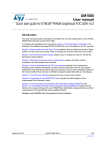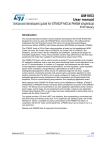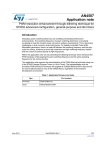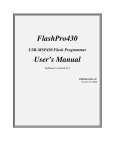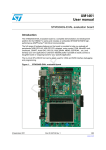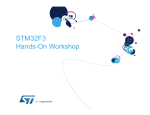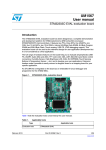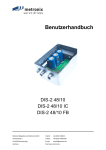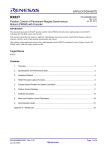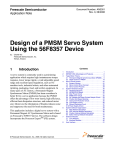Download Dual PMSM motor drive using STM32F303CB/CC peripherals in
Transcript
DT0012 Design tip Dual PMSM motor drive using STM32F303CB/CC peripherals in “time-sharing” By Gianluigi Forte, Dino Costanzo Main components STM32F303CB/CC Analog and DSP with FPU ARM Cortex-M4 MCU up to 256KB Flash+48KB SRAM 4 ADCs, 2 DAC ch., 7 comp, 4 PGA, timers, 2.0-3.6 V operation Introduction The aim of this paper is to describe the intended use of STM32F303CB/CC microcontroller to implement a simultaneous dual PMSM motor drive exploiting the internal peripherals (the embedded PGAs and the analog to digital converters) in “time sharing” for three shunts current reading topology. This means that, during the control of the two motors, the peripherals are reserved for each driver in two “not-overlapping” time intervals. Two different approaches for the motor current sensing amplification network will be analyzed: using the embedded PGAs and using external operational amplifiers. A hardware solution will be proposed for both cases to use the STM32303C-EVAL board implementing these methods to share the required resources. And finally it will be described how to setup the STM32 FOC SDK to implement the explained methods. 1. Time-sharing principle and resources usage Even when the three shunts topology is used to measure the motor phase currents, just two simultaneous sampling of voltage drop into the shunts resistor is required. Applying the Kirchhoff’s current law the third current can be computed from the other two. So basically, two analog to digital converters (ADCs) properly synchronized, is the minimum requirement to implement a three shunts current reading for one motor. Moreover, if the amplification of the current measurement signals is performed using the embedded PGA peripheral, two of them, able to switch properly the inputs among a set of three, are required for each motor. To drive two PMSM motors with the same microcontroller this requirements shall be duplicated. April 2014 DT0012Rev 1 1/10 www.st.com 1.1. Using external operational amplifiers for the motor current sensing amplification network In Figure 1 is shown the block diagram of one solution to converters (ADC1 and ADC2) to exploit the dual three resources”. In Figure 1 is shown the block diagram of one solution to converters (ADC1 and ADC2) to exploit the dual three resources”. share the two analog to digital shunt sampling using “shared share the two analog to digital shunt sampling using “shared Figure 1 - Shared resources using external operational amplifiers PA2 – ADC1 MC1_CurrB PA3 – ADC1 MC2_CurrB PC2 – ADC12 ADC1 MC1_CurrA PC3 – ADC12 MC2_CurrA PA6 – ADC2 MC1_CurrC ADC2 PC0 – ADC2 MC2_CurrC 1.2. Using the embedded PGAs for the motor current sensing amplification network In Figure 2 is shown the block diagram of one solution to share the two embedded OPAMs (OPAMP1 and OPAMP3) and two analog to digital converters (ADC1 and ADC3) to exploit the dual three shunt sampling using “shared resources”. April 2014 DT0012Rev 1 2/10 www.st.com Figure 2 - Shared resources using embedded PGAs PB11 PD14* To COMP PA7 MC1_CurrB OPAMP1 PA3 MC2_CurrB PA5 + PA1 - ADC1 MC1_CurrA MC2_CurrA OPAMP3 PB13 + PB0 - MC1_CurrC ADC3 MC2_CurrC Note: With reference of Figure 2, two inputs of the OPAMP1: PA5 and PA3 have to be connected respectively to pins PB11 and PD14 to be as internal comparators input for over current protection. The remaining OPAMPs inputs are already comparators inputs. 2. Hardware solution To allow the STM32303C-EVAL board to implement one of the two described techniques is possible to use a specific daughter board to be plugged on top of the two extension connectors CN6 and CN7. In Figure 3 are shown the schematics of the daughter board. April 2014 DT0012Rev 1 3/10 www.st.com Figure 3 - Schematic of daughter board The proposed daughter board can be configured for both methods using the R7, R8, R9, R10, R11, R12, R13, R14, R15, R17, R18, R19 resistors as described in Table 1. Table 1 - Daughter board allowed configurations Configuration Resistors R7, R9, R11, R13, R15, R17 Shared resources using embedded PGAs R8, R10, R12, R14, R18 R19 R7, R9, R11, R13, R17, R19 Shared resources using external operational amplifiers R8, R10, R12, R14, R15, R18 April 2014 DT0012Rev 1 Settings Mounted with 5.1kΩ Not mounted Mounted with 0Ω Not mounted Mounted with 0Ω 4/10 www.st.com Some PCB reworks, of the STM32303C-EVAL evaluation board, are needed for motor control applications to disconnect peripherals which share I/Os with motor control. See UM1567 paragraph 2.21. In the Table 2 are reported the configurations of STM32303C-EVAL board switches and solder bridges to implement the two techniques of current sensing using “shared resources”. Table 2 - Switches and solder bridges to be configured in STM32303C-EVAL PGM Resistors and solder bridges Settings R113, R116 R132, R134 Mounted with 0Ω SB2, SB5 Open SB11 Closed PGM1 PGM2 To connect the DB_PB11 (pin51 of CN6 extension connector) to the pin PB11 of the STM32F303VCT6 microcontroller present in the STM32303C-EVAL, is required to solder SB11, remove R137 and mount R36 with 0Ω. Note: For both current sensing methods using “shared resources” it is necessary to use the two 34-pins connector CN2 and CN4 (MC connector) present in the daughter board instead of the two (CN2 and CN4) of the STM32303C-EVAL board. In Figure 4, Figure 5 and Figure 6 are shown respectively the top layout, the bottom layout and the silkscreen of the daughter board. April 2014 DT0012Rev 1 5/10 www.st.com Figure 4 - Daughter board top layer Figure 5 - Daughter board bottom layer April 2014 DT0012Rev 1 6/10 www.st.com Figure 6 - Daughter board silkscreen 3. How to configure the firmware For project based on STM32F303, the STM32 FOC SDK v3.4 supports the dual PMSM motor drive using three shunts topology with “shared resource”. Both methods are supported: embedded PGA, external OPAMPs. To enable these functionalities is necessary to create a new “PMSM – Dual FOC” project using the ST MC Workbench. Make sure that “Current reading topology” of both power stages are selected in “Three Shunt Resistors”. Select the required “Current sensing topology” in the “Control Stage – Analog input and protection” section. The two setting must be the same for both motors. Check the “Shared resource” check box in the “Control Stage – Analog input and protection” section like shown in Figure 7. April 2014 DT0012Rev 1 7/10 www.st.com Figure 7 - ST MC Workbench - Control Stage - Analog Input 4. Support material Related design support material STM32303C-EVAL – product evaluation board for STM32F303xx microcontrollers Documentation Datasheet STM32F303x Datasheet STM32F302x User manual, UM1567, STM32303C-EVAL evaluation board User manual, UM1080, Quick start guide for STM32F0x/F100xx/F103xx/F2xx/F30x/F4xx PMSM single/dual FOC SDK V3.4 User manual, UM1052, STM32F0x/F100xx/F103xx/F2xx/F30x/F4xx PMSM single/dual FOC SDK v3.4 April 2014 DT0012Rev 1 8/10 www.st.com 5. Revision history Date 24-Apr-2014 April 2014 Version 1 Changes Initial release DT0012Rev 1 9/10 www.st.com Please Read Carefully Information in this document is provided solely in connection with ST products. STMicroelectronics NV and its subsidiaries (“ST”) reserve the right to make changes, corrections, modifications or improvements, to this document, and the products and services described herein at anytime, without notice. All ST products are sold pursuant to ST’s terms and conditions of sale. Purchasers are solely responsible for the choice, selection and use of the ST products and services described herein, and ST assumes no liability whatsoever relating to the choice, selection or use of the ST products and services described herein. No license, express or implied, by estoppel or otherwise, to any intellectual property rights is granted under this document. If any part of this document refers to any third party products or services it shall not be deemed a license grant by ST for the use of such third party products or services, or any intellectual property contained therein or considered as a warranty covering the use in any manner whatsoever of such third party products or services or any intellectual property contained therein. UNLESS OTHERWISE SET FORTH IN ST’S TERMS AND CONDITIONS OF SALE ST DISCLAIMS ANY EXPRESS OR IMPLIED WARRANTY WITH RESPECT TO THE USE AND/OR SALE OF ST PRODUCTS INCLUDING WITHOUT LIMITATION IMPLIED WARRANTIES OF MERCHANTABILITY, FITNESS FOR A PARTICULAR PURPOSE (AND THEIR EQUIVALENTS UNDER THE LAWS OF ANY JURISDICTION), OR INFRINGEMENT OF ANY PATENT, COPYRIGHT OR OTHER INTELLECTUAL PROPERTY RIGHT. ST PRODUCTS ARE NOT DESIGNED OR AUTHORIZED FOR USE IN: (A) SAFETY CRITICAL APPLICATIONS SUCH AS LIFE SUPPORTING, ACTIVE IMPLANTED DEVICES OR SYSTEMS WITH PRODUCT FUNCTIONAL SAFETY REQUIREMENTS; (B) AERONAUTIC APPLICATIONS; (C) AUTOMOTIVE APPLICATIONS OR ENVIRONMENTS, AND/OR (D) AEROSPACE APPLICATIONS OR ENVIRONMENTS. WHERE ST PRODUCTS ARE NOT DESIGNED FOR SUCH USE, THE PURCHASER SHALL USE PRODUCTS AT PURCHASER’S SOLE RISK, EVEN IF ST HAS BEEN INFORMED IN WRITING OF SUCH USAGE, UNLESS A PRODUCT IS EXPRESSLY DESIGNATED BY ST AS BEING INTENDED FOR “AUTOMOTIVE, AUTOMOTIVE SAFETY OR MEDICAL” INDUSTRY DOMAINS ACCORDING TO ST PRODUCT DESIGN SPECIFICATIONS. PRODUCTS FORMALLY ESCC, QML OR JAN QUALIFIED ARE DEEMED SUITABLE FOR USE IN AEROSPACE BY THE CORRESPONDING GOVERNMENTAL AGENCY. Resale of ST products with provisions different from the statements and/or technical features set forth in this document shall immediately void any warranty granted by ST for the ST product or service described herein and shall not create or extend in any manner whatsoever, any liability of ST. ST and the ST logo are trademarks or registered trademarks of ST in various countries. Information in this document supersedes and replaces all information previously supplied. The ST logo is a registered trademark of STMicroelectronics. All other names are the property of their respective owners. © 2014 STMicroelectronics - All rights reserved STMicroelectronics group of companies Australia - Belgium - Brazil - Canada - China - Czech Republic - Finland - France - Germany - Hong Kong - India - Israel Italy - Japan - Malaysia - Malta - Morocco - Philippines - Singapore - Spain - Sweden - Switzerland - United Kingdom - United States of America www.st.com April 2014 DT0012Rev 1 10/10 www.st.com











